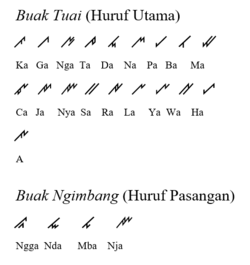Rejang script
| Rejang ꥆꤰ꥓ꤼꤽ ꤽꥍꤺꥏ | |
|---|---|
 | |
| Script type | Abugida
|
Time period | ?–present |
| Direction | left-to-right |
| Languages | Malay, Rejang |
| Related scripts | |
Parent systems | |
Sister systems | Balinese Batak Baybayin scripts Javanese Lontara Makasar Old Sundanese Rencong |
| ISO 15924 | |
| ISO 15924 | Rjng, 363 |
| Unicode | |
Unicode alias | Rejang |
Unicode range | U+A930–U+A95F |
This article needs additional citations for verification. (August 2018) |
| Brahmic scripts |
|---|
| The Brahmic script and its descendants |
The Rejang, Redjang, or Kaganga script, locally known as Surat Ulu ('upstream script'), is an abugida of the Brahmic family, and is related to other scripts of the region, like Batak, Lontara, and others. Rejang is a member of the closely related group of Surat Ulu scripts that include the script variants of Bengkulu, Lembak, Lintang, Lebong, and Serawai. Other scripts that are closely related, and sometimes included in the Surat Ulu group, are Kerinci and Lampung. The script was in use prior to the introduction of Islam to the Rejang area; the earliest attested document appears to date from the mid-18th century CE. The Rejang script is sometimes also known as the KaGaNga script following the first three letters of the alphabet. The term KaGaNga was never used by the users of the script community, but it was coined by the British anthropologist Mervyn A. Jaspan (1926–1975) in his book Folk literature of South Sumatra. Redjang Ka-Ga-Nga texts. Canberra, The Australian National University 1964.
The script was used to write texts in Malay and Rejang, which is now spoken by about 200,000 people living in Indonesia on the island of Sumatra in the southwest highlands, north Bengkulu Province, around , , Curup, and Kepahiang, and also in the Rawas area of South Sumatra Province, near . There are five major dialects of Rejang: Lebong, Musi, Kebanagung, Pesisir (all in Bengkulu Province), and Rawas (in South Sumatra Province). Most of its users live in fairly remote rural areas, of whom slightly less than half are literate.
The traditional Rejang corpus consists chiefly of ritual texts, medical incantations, and poetry.
Letters[]
Letters of the script can be found in the inscription below:[1][2]

Letters with IPA[]
The script's diacritics are attached here to the base letter a (ꥆ) to disambiguate similar ones if the base letter isn't used, like in the case with /i/, /u/, /əu̯/, and /ɛa̯/. Exception for the virama, in which its base letter is ka (ꤰ).
| Rejang abugida with IPA notation[3] | ||||||||||||||||
| Rejang | ꤰ | ꤱ | ꤲ | ꤳ | ꤴ | ꤵ | ꤶ | ꤷ | ꤸ | ꤹ | ꤺ | ꤻ | ꤼ | ꤽ | ꤾ | ꤿ |
| IPA | [k] | [ɡ] | [ŋ] | [t] | [d] | [n] | [p] | [b] | [m] | [c] | [ɟ] | [ɲ] | [s] | [r] | [l] | [j] |
| Rejang | ꥀ | ꥁ | ꥂ | ꥃ | ꥄ | ꥅ | ꥆ | ꥆꥇ | ꥆꥈ | ꥆꥉ | ꥆꥊ | ꥆꥋ | ꥆꥌ | ꥆꥍ | ꥆꥎ | ꥆꥏ |
| IPA | [w] | [h] | [mb] | [ŋg] | [nd] | [ɲɟ] | [a], [ə] | [i], [ɪ] | [u], [ʊ] | [ɛ], [e] | [ai̯] | [o], [ɔ] | [au̯] | [əu̯] | [ɛa̯] | final [ŋ] |
| Rejang | ꥆꥐ | ꥆꥑ | ꥆꥒ | ꤰ꥓ | ||||||||||||
| IPA | final [n] | final [r] | final [ʔ] | (no vowel) | ||||||||||||
Unicode[]
Rejang script was added to the Unicode Standard in April, 2008 with the release of version 5.1. The Unicode block for Rejang is U+A930–U+A95F:
| Rejang[1][2] Official Unicode Consortium code chart (PDF) | ||||||||||||||||
| 0 | 1 | 2 | 3 | 4 | 5 | 6 | 7 | 8 | 9 | A | B | C | D | E | F | |
| U+A93x | ꤰ | ꤱ | ꤲ | ꤳ | ꤴ | ꤵ | ꤶ | ꤷ | ꤸ | ꤹ | ꤺ | ꤻ | ꤼ | ꤽ | ꤾ | ꤿ |
| U+A94x | ꥀ | ꥁ | ꥂ | ꥃ | ꥄ | ꥅ | ꥆ | ꥇ | ꥈ | ꥉ | ꥊ | ꥋ | ꥌ | ꥍ | ꥎ | ꥏ |
| U+A95x | ꥐ | ꥑ | ꥒ | ꥓ | ꥟ | |||||||||||
| Notes | ||||||||||||||||
A proposal is being developed to add Rejang numbers (angka bejagung).[4]
References[]
- ^ Crawfurd, John. (1820). History of the Indian Archipelago (vol. 2).
- ^ Everson, Michael. (2006). Proposal for encoding the Rejang script in the BMP of the UCS.
- ^ Omniglot. Rejang. Retrieved 23 March 2019.
- ^ Pandey, Anshuman (2018-03-26). "Preliminary proposal to encode Rejang Numbers in Unicode" (PDF). Unicode Consortium. L2/L2018/18081. Retrieved 2021-02-18.
See also[]
- Brahmic scripts
- Indonesian scripts